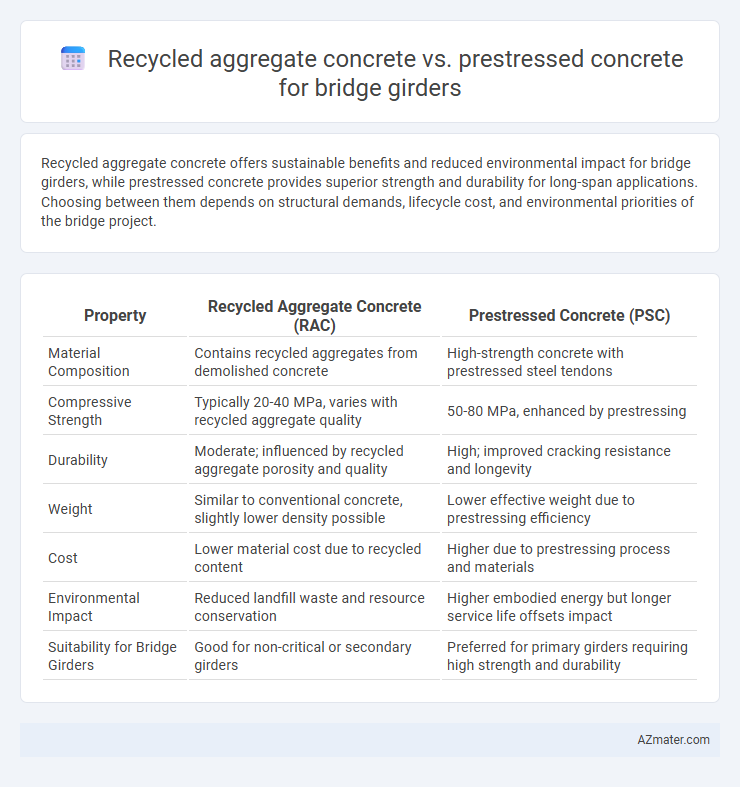Recycled aggregate concrete offers sustainable benefits and reduced environmental impact for bridge girders, while prestressed concrete provides superior strength and durability for long-span applications. Choosing between them depends on structural demands, lifecycle cost, and environmental priorities of the bridge project.
Table of Comparison
| Property | Recycled Aggregate Concrete (RAC) | Prestressed Concrete (PSC) |
|---|---|---|
| Material Composition | Contains recycled aggregates from demolished concrete | High-strength concrete with prestressed steel tendons |
| Compressive Strength | Typically 20-40 MPa, varies with recycled aggregate quality | 50-80 MPa, enhanced by prestressing |
| Durability | Moderate; influenced by recycled aggregate porosity and quality | High; improved cracking resistance and longevity |
| Weight | Similar to conventional concrete, slightly lower density possible | Lower effective weight due to prestressing efficiency |
| Cost | Lower material cost due to recycled content | Higher due to prestressing process and materials |
| Environmental Impact | Reduced landfill waste and resource conservation | Higher embodied energy but longer service life offsets impact |
| Suitability for Bridge Girders | Good for non-critical or secondary girders | Preferred for primary girders requiring high strength and durability |
Introduction to Bridge Girder Construction Materials
Bridge girder construction materials significantly influence the structural performance and sustainability of bridges. Recycled aggregate concrete (RAC) utilizes demolished concrete waste as coarse aggregates, offering environmental benefits and reduced natural resource consumption, while maintaining comparable compressive strength to conventional concrete. Prestressed concrete incorporates high-tensile steel tendons tensioned before or after concrete casting, enhancing load-carrying capacity, durability, and resistance to tensile stresses, making it ideal for long-span bridge girders.
Overview of Recycled Aggregate Concrete
Recycled aggregate concrete (RAC) for bridge girders incorporates crushed concrete debris as a sustainable substitute for natural aggregates, reducing environmental impact and promoting resource efficiency. Studies show RAC maintains adequate compressive strength and durability for structural applications, though careful mix design and quality control are essential to mitigate variability in recycled materials. While prestressed concrete offers high tensile strength through internal steel tensioning, RAC presents an eco-friendly alternative with comparable performance potential when optimized for specific load and durability requirements.
Fundamentals of Prestressed Concrete
Prestressed concrete for bridge girders utilizes high-strength steel tendons tensioned before or after concrete casting to counteract tensile stresses, improving load-carrying capacity and crack resistance. Recycled aggregate concrete incorporates recycled materials reducing environmental impact but may exhibit lower durability and strength compared to prestressed concrete. The fundamental advantage of prestressed concrete lies in its ability to control tensile stresses, allowing longer spans and slender sections ideal for bridge girder applications.
Material Properties Comparison
Recycled aggregate concrete exhibits lower compressive strength and higher water absorption compared to prestressed concrete, impacting durability and load-bearing capacity in bridge girders. Prestressed concrete demonstrates superior tensile strength and reduced creep and shrinkage, enhancing structural performance under heavy loads. Material density differences influence stiffness, with prestressed concrete offering greater rigidity crucial for long-span bridge girders.
Structural Performance Under Load
Recycled aggregate concrete (RAC) for bridge girders exhibits lower compressive strength and reduced modulus of elasticity compared to prestressed concrete, affecting its load-bearing capacity and deflection behavior under heavy traffic loads. Prestressed concrete girders demonstrate superior structural performance with enhanced tensile strength and crack resistance, enabling longer spans and reduced girder depth. RAC can be optimized with proper mix design and treatment of recycled aggregates but generally requires conservative design provisions to ensure reliability under dynamic and cyclic loads.
Durability in Harsh Environments
Recycled aggregate concrete (RAC) offers enhanced sustainability but may exhibit reduced durability in harsh environments due to higher porosity and potential chloride ion penetration, affecting steel reinforcement corrosion resistance. Prestressed concrete, by contrast, demonstrates superior durability through controlled cracking and higher resistance to environmental stresses, especially in aggressive conditions such as marine or industrial atmospheres. Optimizing mix design and corrosion protection techniques can improve RAC's performance, though prestressed concrete remains the preferred choice for bridge girders requiring long-term durability.
Sustainability and Environmental Impact
Recycled aggregate concrete (RAC) reduces environmental impact by reusing construction waste, lowering demand for natural aggregates, and decreasing landfill contributions. Prestressed concrete enhances material efficiency by allowing longer spans and thinner sections, which reduces the overall volume of concrete and steel needed. Both materials support sustainability, with RAC emphasizing resource conservation and prestressed concrete optimizing structural performance to minimize carbon footprint.
Cost Efficiency and Life Cycle Analysis
Recycled aggregate concrete (RAC) offers significant cost savings in material procurement by utilizing waste concrete, reducing expenses associated with raw aggregate extraction and transportation. Prestressed concrete, while having higher initial costs due to specialized production and tensioning processes, provides enhanced durability and load-carrying capacity that can lower maintenance and rehabilitation expenses over the bridge girder's lifespan. Life cycle analysis reveals that RAC can decrease environmental impact and upfront costs, but prestressed concrete's extended service life and superior structural performance often result in greater long-term economic efficiency for bridge girder applications.
Construction Techniques and Challenges
Recycled aggregate concrete (RAC) for bridge girders requires specialized mixing and quality control processes to address variability in aggregate properties and ensure durability, while prestressed concrete demands precise tensioning and anchorage systems to achieve the required load-bearing capacity. Construction challenges for RAC include managing potential reductions in compressive strength and increased permeability, necessitating enhanced curing techniques. Prestressed concrete involves complex staging and sequencing of stressing operations, requiring skilled labor and stringent monitoring to prevent premature cracking and ensure structural integrity.
Suitability for Modern Bridge Design
Recycled aggregate concrete offers sustainable benefits by reducing natural resource consumption and waste, making it suitable for environmentally conscious modern bridge designs. Prestressed concrete provides superior strength and durability, essential for long-span bridge girders requiring high load-bearing capacity and reduced maintenance. Choosing between recycled aggregate and prestressed concrete depends on design priorities such as sustainability, structural performance, and lifecycle cost in contemporary bridge engineering.

Infographic: Recycled aggregate concrete vs Prestressed concrete for Bridge girder
 azmater.com
azmater.com